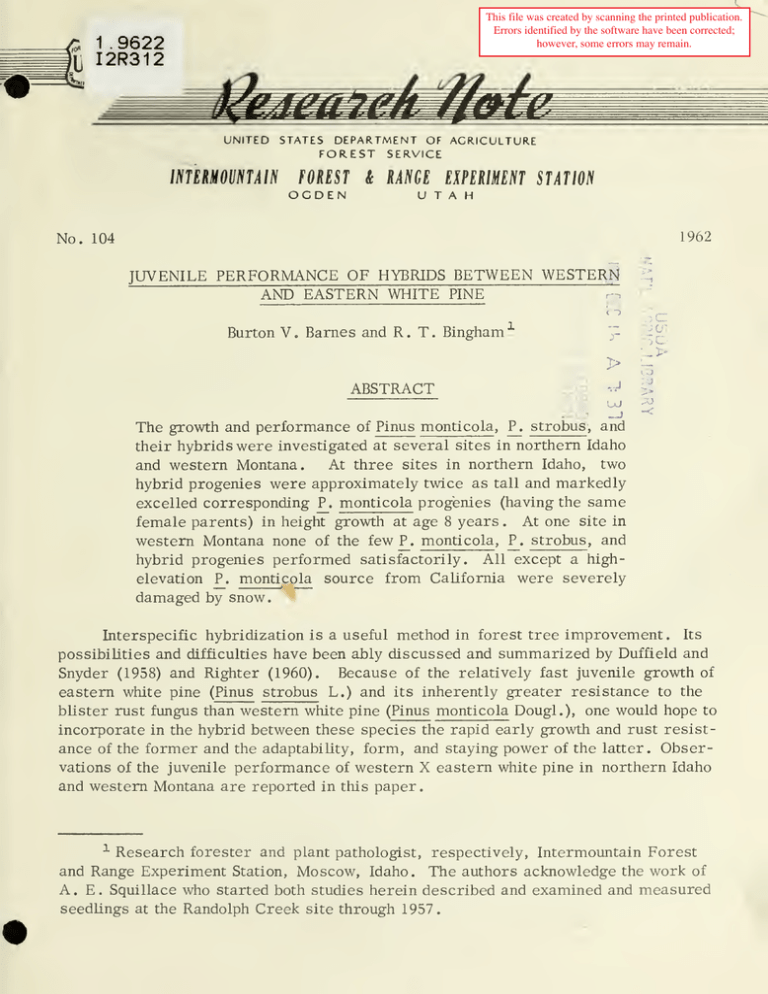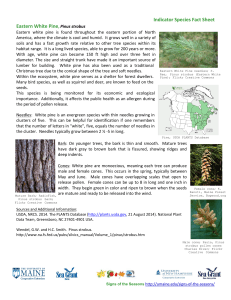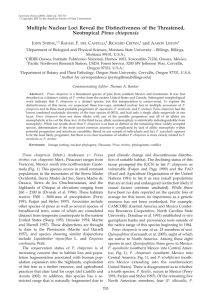uue mEmmuifi UTAH ^
advertisement

This file was created by scanning the printed publication. Errors identified by the software have been corrected; however, some errors may remain. UNITED STATES DEPARTMENT OF AGRICULTURE FOREST SERVICE mEmmuifi forest OCDEN & uue EXPEmEm UTAH statwh 1962 No. 104 JUVENILE PERFORMANCE OF HYBRIDS BETWEEN WESTERN AND EASTERN WHITE PINE ^ [~ Burton V. Barnes and R. T. Bingham ABSTRACT - J The growth and performance of Pinus monticola P_. strobus, and their hybrids were investigated at several sites in northern Idaho , At three sites in northern Idaho, two and western Montana. hybrid progenies were approximately twice as tall and markedly excelled corresponding P. monticola progenies (having the same At one site in female parents) in height growth at age 8 years western Montana none of the few P. monticola P_. strobus and hybrid progenies performed satisfactorily. All except a highelevation P. monticola source from California were severely damaged by snow. . , , improvement. Its possibilities and difficulties have been ably discussed and summarized by Duffield and Snyder (1958) and Righter (1960). Because of the relatively fast juvenile growth of Interspecific hybridization is a useful method in forest tree eastern white pine (Pinus strobus L.) and its inherently greater resistance to the blister rust fungus than western white pine (Pinus monticola Dougl.), one would hope to incorporate in the hybrid between these species the rapid early growth and rust resistance of the former and the adaptability, form, and staying power of the latter. Observations of the juvenile performance of western X eastern white pine in northern Idaho and western Montana are reported in this paper. ' Research forester and plant pathologist, respectively, Intermountain Forest and Range Experiment Station, Moscow, Idaho. The authors acknowledge the work of A. E. Squillace who started both studies herein described and examined and measured seedlings at the Randolph Creek site through 1957. . . Hybrids between Pinus monticola and P. strobus were first produced at the InstiForest Genetics, Placerville, California (Righter 1945), and subsequently grown and studied by a number of scientists. Duffield and Righter (1953) reported that the hybrid grew faster than either parent in numerous experiments at the Institute of Forest Genetics. Riker and Patton (1954) observed some reciprocal crosses showing hybrid vigor when 2 years old. Generally in Wisconsin, however, the hybrid is intermediate in most respects between the parents Bingham, Squillace, and Patton (1956) found that many individual hybrids displayed hybrid vigor during. the first 2 years at Spokane, Washington; further, hybrid progeny height at 2 years was highly and significantly correlated with that of corresponding intraspecies progenies However, juvenile progenies of P. strobus and the hybrid were more severely damaged by snow than the stockier, slower growing P. monticola progenies tute of . PINUS STROBUS PLANTATIONS IN Seldom NORTHERN IDAHO AND WESTERN MONTANA it possible to study extensively the growth and parent in habitats of the native parent. We are, howadaptability of a hybrid's exotic ever, fortunate that from 1911 until about 1932 more than 2,000 acres were planted with P. strobus in northern Idaho and western Montana. Today, more than 1, 000 acres of P. strobus in approximately 14 plantations still exist in the United States is The juvenile performance of P. strobus was studied by foresters, most notably Davids. Olson, nurseryman and later chief of planting in Region 1, U.So Forest Service, from 1915 until 1934. Olson observed poor survival of P. strobus in several blocks of one plantation, presumably unsuited to the species because of aspect, exposure (south and southwest slopes), and rocky, shallow soil. In other areas within this plantation, growth was excellent. He noted that although eastern white pine was damaged by snow during the first 10 years, it outgrew the deformities and thereafter grew rapidly Eastern white pines in five plantations were observed and their grovNth and form compared with those of adjacent plantations or intermingled individuals of western white pine. The source of P. strobus seed was known only by the state in which the seed was purchased. In three plantations (planted 1913-1916) P. strobus had failed on the poorer sites. Where the site was favorable, P. strobus grew well and exhibited relatively good stem form. However, height growth during the last 10 years has diminished and some crown damage was observed. Western white pines, intermingled with eastern white pines in these plantations are now faster growing. In one 30-year-old 2 Personal communication, R. F. Patton, Associate Professor of Plant Pathology, University of Wisconsin, Madison, March 6, 1962. ^ The numbers of plantations and acres are approximate because records are incomplete, not all plantations have been observed recently, and fire has destroyed parts of the most extensive plantations „ * Olson, David S. Final report of Little North Fork Plantations, Misc. Projects 18-32, St, Joe National Forest, U.S. Forest Service, Unpublished Report: 15 pp. 1928. 2 . plantation (Fedar Creek, Kaniksu National Forest), eastern white pine was markedly an adjoining plantation of western white pine of the same age (source unknown). From subjective observations, it appears that although P. strobus may grow faster in youth, western white pine can surpass it within Because of the better adaptation of western white pine to the environmental 50 years conditions of its native habitat, it probably can markedly excel eastern white pine in an inferior in form and vigor in comparison to . 80- to 120-year rotation. The most important observation from the standrandomly selected in these P. strobus plantations point of interspecific hybridization is that P. strobus of essentially sources can compete successfully with western white pine during the first 20 to 40 years on certain favorable sites. Only a few sources of P. strobus were represented in the plantations, and occasionally seed from two or three sources was planted at the same location. Thus, extensive provenance tests would be required to show which sources of P. strobus compete most favorably with western white pine. PERFORMANCE OF HYBRID WHITE PINES The juvenile performance of the hybrid and its parents was compared in two experiments. One experiment was established in an area of heavy rust infection at Randolph Creek, Coeur d'Alene National Forest, in 1954, to study the rust resistance and vigor of interspecific white pine hybrids Further comparisons are possible from a second experiment consisting of vigor-quality outplantings established at three sites in northern Idaho in 1957 (Deception Creek Experimental Forest, Coeur d'Alene National Forest; Priest River Experimental Forest, Kaniksu National Forest; Emerald Creek, St. Joe National Forest). . RANDOLPH CREEK HYBRID EXPERIMENTAL PLOT In the spring of 1954, white pine species and hybrids were planted in three ranRandolph Creek, a deep- snow area in Mineral County, Montana (elev. 4, 240 feet). Seedlings were measured and examined periodically for blister rust cankers. Differences in percent of trees infected per progeny (range to 32 percent)^ were largely attributable to seedling height (table 1). The number of cankered trees per progeny showed a highly significant positive correlation with mean total height of the progeny (r = 840) domized blocks at . Results of the growth measurements in 1961 of the 11 -year-old trees reveal that no source of P. monticola P. strobus or their hybrids is performing satisfactorily (table 1). All progenies except Eldorado County, California, P. monticola have been severely damaged by snow. An inadequate number of surviving individuals within progenies prevented a meaningful comparison in either blister rust susceptibility or growth rate between P. strobus and P. monticola and their hybrids Thus far the best overall performance was shown by the hybrid between P. strobus and P. monticola from ~ Eldorado C ounty, California. " Progenies with fewer than 10 living trees in 1957 were excluded. , , . 3 Table 1 .--Survival and growth of Rnus monticola, their hybrids at Randolph Creek, Seed parent : Pollen : : parent : Seedlings : planted : Spring 1954 : Survival Fall : : - Fall 1954 1961 - Percent - - P. strobus Montana : and ^ Cankered trees 1957 : : , Av : Trees :Percent : total height Fall Fall living :cankered :1954 - . - - 1956 Feet : : Fall : : 1961 : Form - P. monticola ^ 7 (Montana) Wind 30 100 87 30 30 0.41 0.77 Wind 29 100 45 22 18 .33 .69 1 Wind 30 93 37 28 14 .38 Wind 30 97 67 29 30 97 59 27 Wind 3 100 67 Wind 7 100 5 100 30 (New Hampshire) mix (Wisconsin) 1.77 Poor .41 Poor .63 1.18 Poor .23 .37 1.10 Fair 16 .34 ^62 1.36 2 50 .28 .52 1.36 2 50 .37 .38 20 2 50 .32 .45 1.36 100 20 21 19 .46 .72 .92 Poor 30 100 13 16 12 .45 .74 1.45 Poor 15 93 3 33 .40 .76 25 99 13 13 18 .44 .74 1.18 30 97 53 28 32 .55 .89 1.80 Poor 30 100 13 19 32 .46 .80 1.87 Poor 30 98 33 24 32 .50 .84 1.84 P. monticola (S. central Wash.)° P. monticola* (Montana)S P. monticola (CaUf., Eldorado Co.)^ Mean P. monticola progenies P. strobus (New Hampshire) Poor P. strobus (Wisconsin) Mean P. P. strobus progenies monticola (S. central P. strobus Wash.) (S. central P. Wash.) monticola (S. central Mean mix (Canada) P. strobus mix P. monticola -- P. strobus Wash.) P. monticola (S. central Wash.) P. strobus ^ progenies P. monticola (Calif., Eldorado Co.)"^ P. strobus P. monticola (CaUf., Eldorado Co.)6 Mean mix P. strobus P. monticola (CaUf.) progenies (Ontario, Can.) X - P. strobus progenies except the two Montana P. monticola progenies was obtained by personnel at the Institute of Forest I. Righter and J. W. Duffield. 2 Kootenai National Forest, drainage and elevation unknown. ^ Probably collected in the vicinity of the Wind River Experimental Forest, Gifford Pinchot National Forest. *2-2 stock when outplanted in spring 1954; all other lots 2-1 stock when outplanted. ^ Rainy Creek, Mineral County, Montana, elevation 4, 000 feet. "^A mix of seed from two areas: 6,300 feet and 7,300 feet elevation. ^P. monticola progenies compared by Duncan's multiple range test; any two values not having a common line are statistically •" Seed for all Genetics, Placerville, California, under the supervision of F. significant (P <0.05). 4 . This test gives no satisfactory evidence for or against hybrid superiority. It that two nearby P. monticola sources are not well adapted to the site and points up the importance of provenance in studying species and hybrid growth performance shows VIGOR-QUALITY PROGENY EXPERIMENTS In 1957 extra seedlings from the blister rust progeny experiment were outplanted northern Idaho: Priest River Experimental Forest, Kaniksu National Forest (elev. 2,500 feet). Deception Creek Experimental Forest, Coeur d'Alene National Forest (elev. 3,650 feet), and Emerald Creek, St. Joe National Forest (elev. 2, 800 feet). The seedlings were weeded in 1957, 1959, and 1960, but otherwise received no cultural care. Height measurements of trees in two hybrid progenies and western white The pine progenies having the same female parents were made in September 1961 hybrid progenies were approximately twice the height of corresponding western white pine progenies at all sites (fig. 1). at three locations in . DISCUSSION AND CONCLUSIONS The excellent juvenile performance of the hybrid at three northern Idaho sites is encouraging; the early fast growth of the P. strobus parent apparently has been transmitted to the hybrid. The fast growth is also heartening since, except for blister rust resistance, parents can be considered a chance combination. The progress of the hybrids will be watched with interest to see if they continue to outperform western white pine. If racial and individual selection were practiced within both species prior to hybridization, hybrid progenies might be produced that would be faster growing and better adapted to certain sites than the two hybrid progenies discussed. At the three northern Idaho sites snow damage has not yet become a problem. If should become a serious problem, the alternative decisions would be to: (1) discontinue all efforts with the hybrid, (2) find provenances of P. strobus better adapted to mountainous conditions, or (3) backcross the hybrid to P. monticola. it The poor performance plot is not discouraging, tested there of the hybrid progenies at the Randolph Creek experimental since even the presumably local western white pine progenies were equally poor. Also, it is not necessary that the hybrid be planted on on those where it would compete equally well with, or excel, P. mon- all sites- -just The apparent adaptability of the high elevation California P. monticola to this deep-snow site, and a growth boost from the P. strobus parent, perhaps combined to ticola. make performer. However, the cross, P. monticola California X P. monticola Idaho, was not tested and might have proved equally good or better. this hybrid the best Although an interspecific hybridization program has promise, no further breeding is planned until races and individuals of both species are screened. 5 8 X i I . 11 .s^ 0) 0) •i-H O C u — o CN o- olO _o _o _0 o X ^ ^ E E e E aJ a.' a.' qJ X X X X _o _o _o _g c ^c c °- Kl 'o X ^ o 1^ —o E E E E Q. a. Q. Q. c Sh <U 4-1 00 be —I o o 0) X u u - HiMOaO 6 iHOI3H u 3 bp fli c S-i LITERATURE CITED Bingham, R. T., A. E. Squillace, and R. F. Patton Vigor, disease resistance, and field performance in juvenile progenies of 1956. the hybrid pines Pinus monticola Dougl. X Pinus strobus L. Ztg. f. Forstgenet. u. Forstpflanzenz 5(4): 104-112. W., and F. I. Righter Annotated list of pine hybrids made at the Institute of Forest Genetics. U.S. Forest Serv. Calif. Forest and Range Expt. Sta. Forest Res. Note 86, 9 pp. Duffield, J. 1953. Duffield, J. W., and E. Bayne Snyder Benefits from hybridizing American forest tree species. 1958. Jour. Forestry 56: 809-815. Righter, 1945. F.I. Pinus: The relationship of seed size and seedling size to inherent vigor. Jour. Forestry 43: 131-137. 1962. Forest tree improvement through inbreeding and intraspecific and interspecific hybridization. Fifth World Forestry Cong. Proc, 1960, V. 2: 783-787. Riker, A. J., and R. F. Patton 1954. Breeding of Pinus strobus for quality and resistance to blister rust. Univ. Wisconsin Forest Res. Note 12, 2 pp. 7


